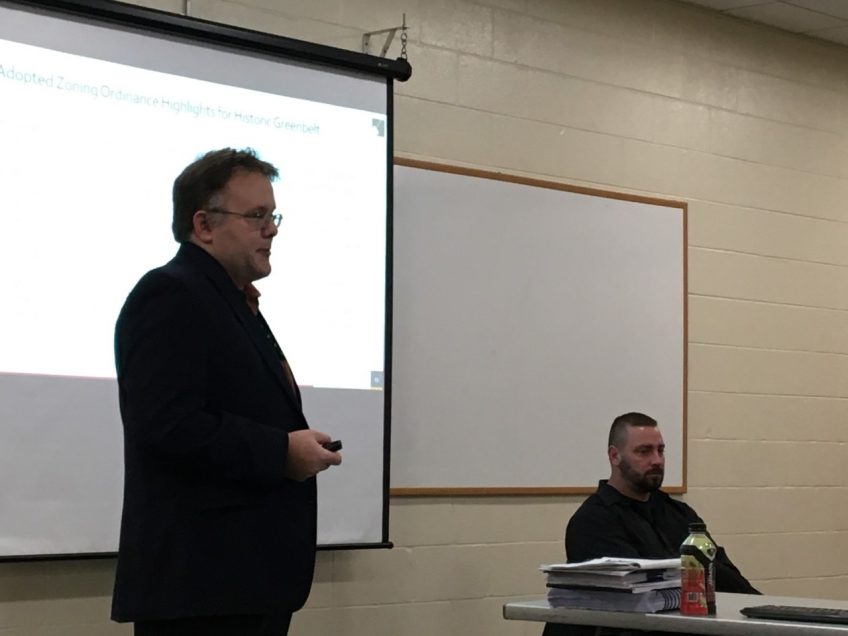Prince George’s County is in the process of revising zoning regulations in its ongoing Countywide Map Amendment project. As a part of that project, a set of special zoning rules is being established to help preserve the unique, historic character of neighborhoods such as Old Greenbelt. On December 17 at the Community Center, Chad Williams, a master planner with the Countywide Planning Division of the Prince George’s County Planning Department of the Maryland-National Capital Park and Planning Commission, discussed how the new Neighborhood Conservation Overlay Zone (NCOZ) will be developed over the next months. The Multipurpose Room was full, with nearly 60 Greenbelt residents in attendance. Williams began the presentation by discussing the Residential Planned Community (RPC) zoning regulations, which are what Greenbelt currently falls under. He explained that the RPC limits residential density by block, requires a detailed site plan (DSP) review for multifamily and non-residential development and also requires a DSP review prior to issuance of any grading or use and occupancy permits. These are valuable authorities for helping control residential density and a historic community’s character, but he went on to say that the RPC can’t do anything else. The RPC standards and land uses are the same as the underlying zones, whether that makes sense or not. Also, under the RPC, any additions and alterations to Greenbelt Homes Inc. townhomes, single-family dwellings and public buildings are exempt from the DSP requirement of the RPC zone. In general, Williams said, single-family residential property under the RPC is treated the same as single-family residential property anywhere else in the county except for density and requiring a DSP prior to issuance of use and occupancy permits. NCOZ Goals The NCOZ, which will replace the RPC, will provide more flexibility and therefore better control of the community’s character, Williams emphasized. It will provide additional or different design standards that could apply to new development or redevelopment such as density, block sizes (walkability will be key), yard depths and building setbacks, and more. Also, the NCOZ will require planning director review for any new construction or expansion resulting in an increase of gross floor area of a building by 15 percent or more. Creating the NCOZ will require a neighborhood study that will specify the development context in the zone. Williams said that the NCOZ purposes and goals include preservation of the development characteristics of the New Deal community, including the existing superblocks, the garden city character, existing sustainable development practices and the existing green belt. The NCOZ will also regulate both the demolition of dwellings and additions to dwellings, limit size of accessory structures and preserve the current number of parking spaces, including no reductions or expansion of existing parking lots wherever possible. NCOZ Timeline Williams said that the NCOZ will be shown on the proposed zoning map, the initial draft of the NCOZ text will be available for review, and there will be an opportunity to testify on the NCOZ in March 2020. The NCOZ text will be converted to legislation and presented as such, and county Planning, Housing and Economic Development Committee worksessions will be held on the proposed legislation. Public comments and written testimony will be accepted in June 2020. Then, the NCOZ zoning map will be approved, along with the Countywide Map Amendment and the NCOZ legislation, after a public hearing and council enactment (done via council bill). The new zoning ordinance and subdivision regulations, including the NCOZ, will take effect in late fall, 2020. Questions After the presentation, many attendees asked questions that largely centered on what will be protected and what won’t be under the NCOZ. Williams responded that the current zoning does not have much logic to it, but that the NCOZ will provide a structure and a logic that can be used to preserve the basic character of the neighborhood. Information on the zoning rewrite and the ongoing Countywide Map Amendment project is available at zoningpgc.pgplanning.com. Electronic copies of the adopted new Zoning Ordinance and Subdivision Regulations are available on the county council project website at pgccouncil. us/ZOR. For additional information about the NCOZ project or to ask questions, contact chad. williams@ppd.mncppc.org or call 301-952-3171.
C. Williams Discusses NCOZ Development Process, Timeline

Chad Williams, Master Planner with the Countywide Planning Division of Prince George's County Planning Deopartment, Maryland National Capital Park and Planning Commission, addresses a group of Greenbelt residents on Tuesday, December 17 concerning the Neighborhood Conservation overlay Zone portion of the new county Zoning Ordinance. Also pictured: a translator for the hearing impaired.
